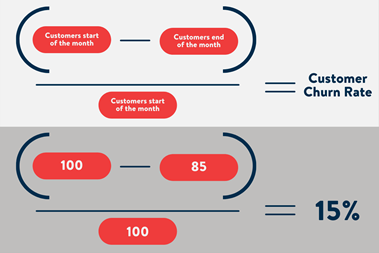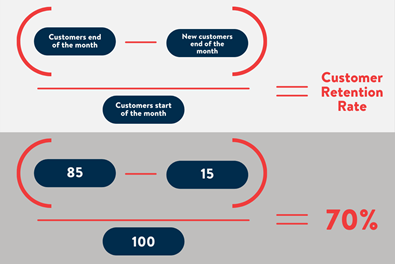A 5% increase in customer retention produces at least a 25% increase in profit (Bain & Company). Often, we think gaining new customers will make us more profitable, but really, it’s keeping customers that help us grow.
What is customer retention?
To quickly recap, the five stages of the buyer’s journey are Awareness, Intention, Consideration, Conversion, and Retention. Just as it’s important to move your guest through the stages to Conversion — where they book a reservation with you — it’s equally important to keep them as customers. You want to encourage them to continue to book experiences with you into the future.
The Retention Stage of the Buyer’s Journey is keeping your customers satisfied and giving them a good reason to continue to book with you.
WHY CUSTOMER RETENTION IS IMPORTANT
5 Quick Facts About Customer Retention and Loyalty
-
50% of customers have left a business to go to their competitor because their competitor could meet their needs better. (InMoment)
-
90% of customers often purchase more than once. (HubSpot Research)
-
In the US, 90% of customers share their customer service experiences with others. (American Express).
-
The probability of selling to an existing customer is 60-70%, while the probability of selling to a new prospect is only 5% to 20%. (Annex Cloud)
-
54% of customers will leave a business if it doesn't have enough engaging content or relevant discounts. (Fundera)
These are just a few quick stats about the importance of customer retention and loyalty. And as you can see, it’s more beneficial for operators to keep their current customers happy than taking their loyalty for granted.
How To Measure Customer Retention
Have you heard the phrase, “What gets measured, gets managed”? If you’re not already measuring your customer retention rate, start measuring it today. You’ll only be able to increase your customer retention rate if you know where it’s at currently.
Customer Churn Rate
Before you can measure your customer retention rate, you need to know the churn rate. That’s the pace at which a customer stops booking with you. Churn rate metrics are expressed as a percentage of your total existing customers. It represents the number of customers who leave over a period.
To calculate your churn rate, take the number of customers you had at the start of the time period and subtract the number of customers you had at the end of the time period.
For example, if you had 100 customers at the beginning of the month and only 85 at the end of the month, you subtract 85 from 100, which gives you 15.
Next, you divide 15 by 100, which gives you a decimal. In our case, this is .15.
Multiply that number by 100 to get a percentage. In this scenario, our customer churn rate is 15%.

Customer Retention Rate
Now that you know what your customer churn rate is, you can calculate your customer retention rate. To do this, subtract the number of new customers in the time frame from the number of customers at the end of the time frame.
Similar to the churn rate formula, if we had 15 new customers in the time frame and we had 85 customers at the end of the time frame, we’d subtract 15 from 85, totaling 70.
Next, divide 70 by the number of customers at the beginning of the time period. In our example above, we started with 100. Dividing 70 by 100 equals .70.
To get a percentage, multiply .70 by 100.
That equals 70%. You can see our customer retention rate is 70%.

Customer Retention Vs Acquisition
It’s actually not an either-or, but both. It’s just as important to keep customers as it is to gain new ones. Simply put, customer acquisition is the process of gaining new customers. It’s how you expand and grow your outfitting business.
Because every business can only spend so much time and money on marketing, it begs the question of which area will yield greater results (make you more profitable)?
Acquisition is more expensive than retention
It can cost upwards of five times as much to acquire customers than to keep the current ones.
Customers become more valuable over time.
The upfront costs of gaining a customer are definitely significant, but if that customer becomes an advocate for your company, there’s a much higher return on investment.
Happy and loyal customers spread the word.
Word-of-mouth marketing, especially between friends and family, is incredibly effective. So effective that 92% of consumers say they trust a friend or family member’s recommendation over a business. Online reviews are another form of marketing because consumers will read reviews before booking a trip with a company. Having positive reviews will boost customers’ confidence.
It’s easier to sell to your current customers because you don’t have to go through the various stages of the buyer’s journey again. They already know who you are, what you do, and what they like about you. By staying on top of mind with your customers, it’s easier and costs less to sell to them.
Loyal customers are repeat guests. They leave raving reviews. They follow you on social media. They subscribe to your newsletters. They amplify your brand both off- and online.
Of course, there’s not a single solution that works for every business. For some more ideas about how to increase retention and build brand advocates, we can take a page out of the hotel industry’s book. Revenue Hub lists strategies for hotels that apply for outdoor recreation companies.
Tools that will help build brand loyalty
Here are some tools to use to build brand loyalty. If your budget allows, take advantage of all these tools. Automating your marketing and staying organized will help you keep customers happy, increase their trust, and build brand advocates.
Calculate your retention rate
If you don’t want to do the math yourself to determine your customer retention rate, CleverTap has a handy calculator that will do it for you.
Manage and email your current or prospective customers
HubSpot Email Marketing- HubSpot offers a ton of tools for businesses big and small. They have a free email marketing tool that can support plenty of small business needs like “thank you” emails, refund emails, and current deals. Plus, if you have the budget, you can use this as a CRM (Client Relationship Manager), a customer service tool, and a total marketing tool.
MailChimp is a well-known free email marketing tool (up to 2,000 contacts) you’ve probably heard of. You can customize email templates to fit your brand, schedule emails, and segment your audience. If all you need is an email provider, this is a good choice.
SalesForce is the most well-known CRM (Customer Relationship Manager). It helps you keep track of your clients and provides them with the best customer service. It’s also really expensive.
Accept customer feedback
Typeform- For those with small budgets or only send out the occasional survey, Typeform is a great free tool to use. You can customize the questions and colors and it’s really easy to use.
Analyze your website metrics
Google Analytics is the best free tool and will provide valuable insight into your website traffic. With Google Analytics, you can see:
-
What page(s) your customers are on the most
-
The time of day your customers are most active
-
The bounce rate (people who land on your website and leave quickly)
-
How many visitors you get a day/week/month
-
Where your visitors are coming from (another website, organic search, social media, etc.)
Use online booking software
Origin helps you by keeping trip reservations and staff availability up-to-date, prevent overbookings with a purpose-built resource management system, and even help you assign guides to newly booked trips with automated text messages to confirm availability.
Manage Your Social Media
Hootsuite- One of the first social media management tools, Hootsuite can manage/is compatible with over 35 social networks including Facebook, Instagram, Twitter, LinkedIn, YouTube, & Pinterest. It’s built for SMBs and Enterprise businesses and it’s an all-in-one platform, offering scheduling, analytics, and monitor conversations.
Buffer Publish- This is a straightforward publishing tool in that it simply lets you schedule posts ahead of time. It supports Facebook, Twitter, LinkedIn, and Instagram, and Pro users can schedule Pinterest updates too. The free plan includes one user, three accounts, and 10 queued posts per profile
About the Author
Jessica is the Digital Marketing Specialist for Origin, an innovative online booking software designed specifically to help tour guides and outfitters keep trip reservations and staff availability up-to-date, prevent overbookings, and even help you assign guides to newly booked trips with automated text messages to confirm availability. Interested in learning more? Schedule a call with us or visit our website: www.exploreorigin.com